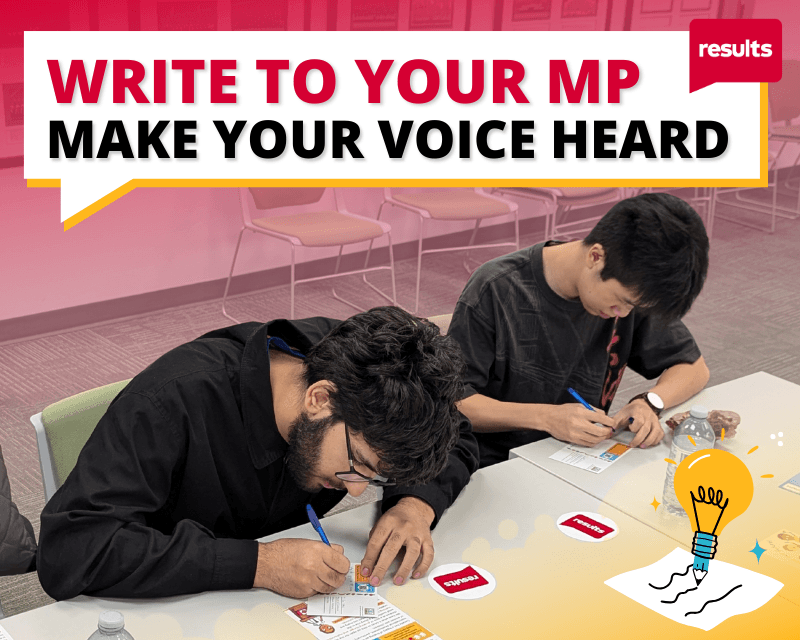
“Democracy is not just about casting votes, but also about ensuring that every voice is heard and respected.”
– Kofi Annan (Former UN Secretary General)
Your voice matters and writing to your Member of Parliament (MP) is one of the most effective ways to be heard and make an impact.
Our MPs depend on constituents and organizations to inform them which issues matter most to the people they represent. By writing to your MP, you’re not only raising awareness — you’re helping generate the political will to end extreme poverty.
While MPs receive hundreds of messages each week, yours will stand out because you are their constituent and you are following Results’ How to write to your MP guideline!
Right now, the world is at a critical point. Countries are stepping back from international development. Escalating conflicts and climate change are making already complex international development and global health issues even more challenging. Canada needs to step up and lead. Your letter can help make the world healthier, more educated, and prosperous.
Writing an original letter or email to your MP boosts your chances of receiving a meaningful reply and pushes them to act. Most MPs respond to constituent letters and often will pass your message to the relevant Minister. By Parliamentary convention, Ministers/Secretaries must then respond to your MP.
Even if your MP isn’t a primary decision-maker on an issue (minister, secretary, etc.), your letter educates them. It puts critical issues on their radar and can encourage them to take action. It also helps them inform their fellow party members.
"The reason it's important to engage us [parliamentarians] is because we don't know everything…it's how we learn… If you engage your MP and you do it in a constructive way, then you can actually help members of parliament really understand the issues… So talk to your MPs!"
- MP Anita Vandenbeld
Sometimes, it may be more strategic or impactful to write directly to the Prime Minister, Ministers, Secretaries of State, or other decision-makers depending on the campaign. Results will let you know when those moments happen in our call to action. However, the best way to create an impact is to start with your MP.
We often see websites where you can enter your postal code, and a pre-written message is automatically sent to your MP. While these templates may be easy to use, MPs and their staff repeatedly tell us that these form emails are often easily dismissed while personalized letters or emails have far more impact. An original message from a passionate constituent is always more powerful than a batch of identical emails.
That’s why we encourage you to speak from the heart. You can use our tips and resources and create something unique from yourself. However, we do provide a suggested layout you can use for your email or letter!
email or letter?
Both work! Some MPs prefer email; others like physical letters. Choose whichever format that you prefer or is most accessible to you.
Letters can be sent postage-free to:
[Your MP’s Name]
House of Commons
Ottawa, ON K1A 0A6
You can find your MP’s email and contact information by entering your postal code at www.ourcommons.ca.
Writing tips:
Use the “EPIC” format! It is a useful way to remember how to structure the main part of your letter or email. After an introductory paragraph that tells them who you are, follow this structure:
E = Engage: Start with a striking fact, story, or statement.
P = Problem: Describe the issue and who it affects.
I = Inform: Offer a solution. Include evidence or examples if possible.
C = Call to Action: Clearly ask your MP to do something — like write to a Minister or speak up in Parliament.
You can find all these elements in our latest call to action.
End your message by asking for a reply. Let them know how to reach you, by email or by mail.
1. Share your action
You did it! That letter or email is a big step. Now share it on social media. Post a photo of your letter or share your experience writing your email. Don’t forget to tag your MP
2. Follow up
If you don’t hear back after two weeks, follow up with a quick call to your MP’s office. Find their number on the House of Commons website.
3. Report back to Results
Let us know you’ve taken action. Submit your report online and send us your MP’s response if you get one. This helps us track actions that were taken to support the campaign.
4. Keep going
Even if you don’t get an answer or the one you hoped for, don’t give up. Your message still made an impression, and future contact could build on that.
5. Stay engaged
Ready, set, write! It's important to remember that your letter doesn’t need to be perfect. It just needs to be passionate and from your heart. Also, your MP wants to hear what issues matter to the people they represent. Your words can help shape Canada’s priorities and policies for a more just world.
Your voice matters. Make sure your Member of Parliament hears it.
Questions? Feel free to email us at parl@resultscanada.ca. We’re happy to help you be as effective as possible when writing to your MP!
